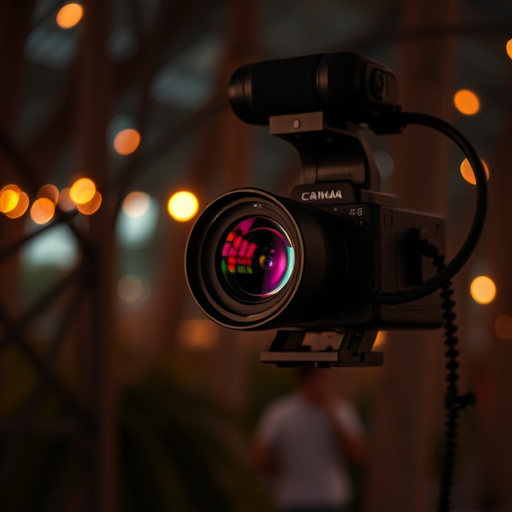Detecting Mini Spy Cameras at night requires advanced infrared (IR) sensors and thermal imaging to identify heat signatures in dark environments. Signal analysis techniques, like IR signal processing, help navigate and locate hidden cameras effectively. Employ countermeasures like RF interference and periodic signal scans to protect against privacy threats from mini spy cameras and nighttime recording devices.
Uncover the insidious world of hidden recording devices with our comprehensive guide. In today’s digital age, privacy concerns are paramount. This article delves into effective scanning methods for detecting mini spy cameras, especially at night. We explore advanced techniques beyond visual cues and delve into signal analysis to bolster detection accuracy. Additionally, learn powerful countermeasures to prevent unseen surveillance, empowering you to protect your personal and professional spaces from covert recording.
- Detecting Mini Spy Cameras: Nighttime Techniques
- Advanced Scanning: Beyond Visual Cues
- Signal Analysis for Enhanced Detection
- Preventing Unseen Surveillance: Countermeasures
Detecting Mini Spy Cameras: Nighttime Techniques
Detecting Mini Spy Cameras at Night requires specialized techniques due to their small size and often low-light operation. One effective method involves using advanced infrared (IR) sensors that can pick up heat signatures emitted by the tiny cameras, which often lack traditional IR filters. These sensors are particularly useful in dark environments, allowing investigators to pinpoint devices hiding within spaces like walls, ceiling tiles, or even potted plants.
Another crucial nighttime technique is thermal imaging, which produces visual representations based on temperature variations. This non-invasive approach can reveal unusual heat patterns indicative of hidden recording devices. By combining thermal imaging with IR sensors and careful analysis of shadows and light distribution, security professionals can successfully locate Mini Spy Cameras operating discreetly in the dark.
Advanced Scanning: Beyond Visual Cues
In the realm of hidden recording device signal scanning, advanced techniques have emerged beyond mere visual cues. This involves delving into the world of infrared and thermal imaging technologies, especially effective for nighttime recordings with mini spy cameras. These methods allow scanners to detect heat signatures, making it possible to uncover devices that might be invisible to the naked eye.
By utilizing specialized equipment, professionals can now identify subtle electromagnetic emissions or anomalies associated with active recording devices. This includes signals from miniature spy cameras concealed in various settings, ensuring a comprehensive search regardless of time of day. Such advanced scanning techniques have revolutionized surveillance practices, providing crucial insights into hidden activities and enhancing security measures in today’s digital era.
Signal Analysis for Enhanced Detection
In the realm of hidden recording device signal scanning, Signal Analysis plays a pivotal role in enhancing detection capabilities, especially for miniature spy cameras designed for nighttime recordings. These tiny yet powerful tools often employ advanced signal processing techniques to overcome the challenges posed by low-light conditions and potential interference. By analyzing various frequency bands and pattern recognition algorithms, these devices can distinguish between ambient noise and the subtle signals emitted by the hidden camera.
For instance, Mini Spy Cameras equipped with infrared (IR) capabilities utilize IR signal analysis to penetrate darkness, ensuring nighttime recordings remain clear and undetected. This method is particularly effective in navigating labyrinthine environments where visual cues are scarce. Through sophisticated signal scanning methods, these devices can detect and record minute IR signals from hidden cameras, providing a robust solution for surveillance needs that demand discreteness and clarity.
Preventing Unseen Surveillance: Countermeasures
Preventing Unseen Surveillance: Countermeasures
In today’s digital era, mini spy cameras and nighttime recording devices have become increasingly accessible, posing a significant threat to privacy. As these hidden recording tools can be easily concealed, it’s crucial to employ countermeasures to protect against unseen surveillance. One effective method is to use advanced signal scanning technologies that detect and identify suspicious electromagnetic emissions. These tools are designed to uncover hidden cameras, tracking devices, and other covert listening equipment, ensuring individuals remain aware of potential threats.
By implementing periodic signal scans, especially in sensitive environments like homes, offices, or public spaces, one can proactively safeguard personal information. Additionally, utilizing RF (radio frequency) interference techniques can disrupt the operation of spy cameras, making it a robust countermeasure against undetected recording devices. Staying informed about the latest privacy protection technologies and staying vigilant is essential to securing personal and private spaces from unseen surveillance.
Hidden recording devices, particularly mini spy cameras, pose a significant threat in today’s digital age. By employing specialized scanning methods like nighttime techniques and advanced signal analysis, we can enhance detection capabilities. Understanding these hidden threats and implementing appropriate countermeasures is essential to safeguard our privacy. Staying informed about the latest advancements in both detection and prevention will ensure we’re one step ahead in navigating this complex landscape of surveillance technology.
